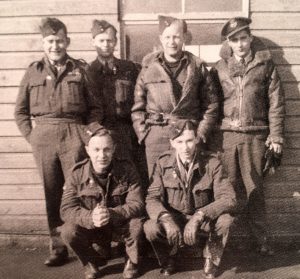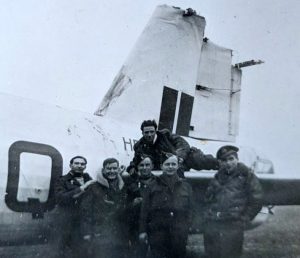
Pilot Don Rollins likely missed it on the first reading of his overseas certification as a bomber pilot in October 1942. It was three years into WWII, and the RCAF trainee from Estevan, Sask., had successfully completed his operational training to fly Wellington bombers in daytime and nighttime missions.
All the 22-year-old Canadian wanted, however, was to fly combat operations against the Germans. Still, at the bottom of the certification, his training officer had added a further endorsement:
“Night vision … Above average!”
A great deal happens in a year during a war. Good and bad. By 1943, Rollins had earned a commission, and now Pilot Officer Rollins had flown anti-U-boat operations from Gibraltar and survived the ditching of a bomber at sea.
Then, back in the UK, in the fall of 1943, Coastal Command had posted P/O Rollins to RCAF No. 407 “Demon” Squadron, famous for hunting down U-boats in the Bay of Biscay. And he’d be flying state-of-the-art Wellington bombers with Leigh Lights and AVS Mark III search radar.
“They are a wizard job!” Rollins wrote in his journal.
The anti-submarine sorties from RAF Chivenor in southwestern England to Biscay proved arduous – 12-hour sweeps through gales, fog, and near-zero visibility.
Suddenly, it was Christmas Eve 1943. The officers’ mess got a real Christmas tree and carols on the radio. Chivenor’s cooks planned a turkey supper with all the trimmings for the next day. But that afternoon Rollins’ crew attended an emergency briefing.
Intelligence revealed that the German navy, taking advantage of the lull, had assembled a convoy of transports and destroyers off the coast of France. No. 407 Squadron would conduct a nighttime raid.
Five hours of night flying put his bomber “Q for Quebec” 500 miles south of England, over the Bay of Biscay where his radar spotted the convoy in the dark. Though his Wellington was equipped with a powerful Leigh Light, experience told him not to turn it on; the bright light would reveal the location of the attacking bomber and attract flak gunners aboard the German warships.
“Dropped a flare to illuminate only the target for a visual attack,” he wrote. “Did a bit of weaving (to dodge the flak) and let go our bomb load and then climbed up to 3,000 feet.”
Rollins was about to bank the aircraft to see the results of his bombing run when ahead he spotted a shadow darker than the gloom of the night. It was another aircraft, an Allied Liberator, he learned later, heading in the opposite direction.
During the seconds it took Rollins to realize his Wellington was about to collide head-on with the Liberator in mid-air, “I immediately slammed the stick forward (to dive) and (the Liberator went) over my head by inches.”
Then came a grinding, wrenching sound of tearing metal in the rear of Rollins’ aircraft. The Wellington shuddered in protest. The rudder pedals below Rollins’ feet snapped to the full-left position and the bomber lurched sharply in a death plunge toward the ocean. The Liberator had struck the Wellington’s tail and sheared off eight feet of rudder.
Rollins shouted to co-pilot Sgt H.S. Butcher to help him pull back on the controls. The bomber finally responded and levelled out of its death dive. Rollins nursed the aircraft back to 3,000 feet to give him a margin of security above Biscay.
He now had three options: ditch the aircraft in the ocean and be captured; survive the ditching, but likely die of exposure; or attempt a nearly impossible five-hour flight back to base. Rollins chose to try for home.
It was dawn when Rollins and Butcher nursed the wobbling Wellington into a final approach to Chivenor airfield. Rollins offered his crew the option of bailing out. Nobody did. His crew trusted their skipper to get them down safely.
Q for Quebec’s wireless operator flashed a signal to base, “Damaged, attempting a landing.” Crash trucks assembled along the runway. Then, with no rudder control, the control column bent, but enough confidence in his 600 hours of flying experience, Rollins brought his bomber down in one piece.

It was 8:30 a.m. when Rollins and his crew gathered around Q for Quebec’s half-sheared-away tail section. When Rollins eventually met the pilot of the Liberator, he learned that the collision had torn away 14 feet of the Liberator’s port wing, but its pilot had likewise brought his aircraft safely home.
The two shook hands and realized but for Rollins’ sharp night vision, neither the pilots nor any of the fifteen men in the two bombers would have lived to enjoy Christmas Day 1943.
In his journal, Don Rollins offered a final thought: “On Christmas we did a shipping strike and how close we came to getting it, only me and the laundry man knows!”
Note: All flight log and journal references, courtesy of Doug Rollins, son of P/O D.E. Don Rollins.
This is fantastic. I’ve recently found out that my grandfather (Jack Mills) was part of this squadron and when I’ve I googled to find out about it, I find this story. Amazing
my father, Jack Mills, is on the photograph, front row on the left.
very interesting article.
thank you
I am researching the airbase at RAF Chivenor and was aware of this incident but this puts it into more context
Will be featuring this incident on the 80th anniversary next week in my history group if anyone involved with this thread would be interested in
Want to feature this incident in my raf Chivenor history group on the 80th anniversary next week and would like to engage with relatives
interested in this article for my RAF Chivenor history group to feature on the 80th anniversary next week